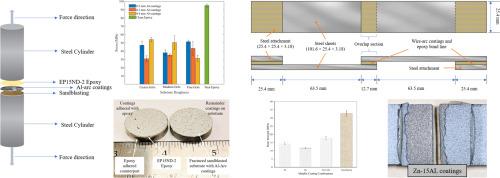Understanding the mechanisms behind the bonding performance of wire arc coatings
IF 6.3
2区 材料科学
Q2 CHEMISTRY, PHYSICAL
引用次数: 0
Abstract
Anodic metals, such as aluminum (Al) and zinc (Zn), are extensively utilized via thermal spraying to form a protective film on structural steel from corrosion. The robustness and durability of thermal spray coatings are significantly influenced by bonding performance, which largely depends on substrate surface roughness and coating thickness. This research assessed the impact of substrate surface roughness and coating thickness on the interfacial bonding performance of wire arc coatings with different coating materials (Zn, Al, and Zn-15Al) on A36 steel surfaces. Pull-off (tensile) and Lap shear (LS) tests were conducted to explore the mechanical properties of metallic coatings adhered to substrates. The pull-off test results demonstrated that thicker coatings formed stronger bonds on coarse surfaces, while thinner coatings performed better on fine surfaces. The LS test showed that pure Al coatings were 25–30 % stronger in shear and fracture elongation than pure Zn coatings. In comparison, Zn-15Al coatings outperformed in shear stress by 15 % over pure Al but exhibited the least resistance to fracture elongation. The effects of substrate roughening, arc spray profiles, and the morphology of the sandblast grits were explored by scanning electron microscopy (SEM) analyses. The elemental composition of the coatings from energy dispersive spectroscopy (EDS) revealed a uniform and continuous coating layer with minimal porosity and oxidation, confirming the effectiveness of thermal spray process. This study contributes to the fundamental understanding of the critical factors in controlling the bonding performance of wire arc coatings, paving the way for the optimization and design framework of metallic coatings.

了解电弧镀层粘合性能背后的机制
阳极金属,如铝(Al)和锌(Zn),通过热喷涂在结构钢上形成保护膜,以防止腐蚀。热喷涂涂层的坚固性和耐久性受到结合性能的显著影响,这在很大程度上取决于基材表面粗糙度和涂层厚度。本研究评估了基体表面粗糙度和涂层厚度对A36钢表面不同涂层材料(Zn、Al和Zn- 15al)的电弧线涂层界面结合性能的影响。采用拉脱(拉伸)和搭剪(LS)试验研究了金属涂层粘附在基体上的力学性能。拉伸测试结果表明,较厚的涂层在粗糙表面上形成更强的粘结,而较薄的涂层在精细表面上表现更好。LS试验表明,纯Al涂层的剪切伸长率和断裂伸长率比纯Zn涂层高25 ~ 30%。相比之下,Zn-15Al涂层的剪切应力性能比纯Al涂层高15%,但抗断裂伸长率最低。通过扫描电子显微镜(SEM)分析了基体粗化、电弧喷射轮廓和喷砂颗粒形貌的影响。能谱分析表明,涂层的元素组成均匀连续,孔隙率和氧化率都很小,证实了热喷涂工艺的有效性。该研究有助于从根本上了解控制电弧镀层结合性能的关键因素,为金属镀层的优化设计框架奠定基础。
本文章由计算机程序翻译,如有差异,请以英文原文为准。
求助全文
约1分钟内获得全文
求助全文
来源期刊

Surfaces and Interfaces
Chemistry-General Chemistry
CiteScore
8.50
自引率
6.50%
发文量
753
审稿时长
35 days
期刊介绍:
The aim of the journal is to provide a respectful outlet for ''sound science'' papers in all research areas on surfaces and interfaces. We define sound science papers as papers that describe new and well-executed research, but that do not necessarily provide brand new insights or are merely a description of research results.
Surfaces and Interfaces publishes research papers in all fields of surface science which may not always find the right home on first submission to our Elsevier sister journals (Applied Surface, Surface and Coatings Technology, Thin Solid Films)
 求助内容:
求助内容: 应助结果提醒方式:
应助结果提醒方式:


